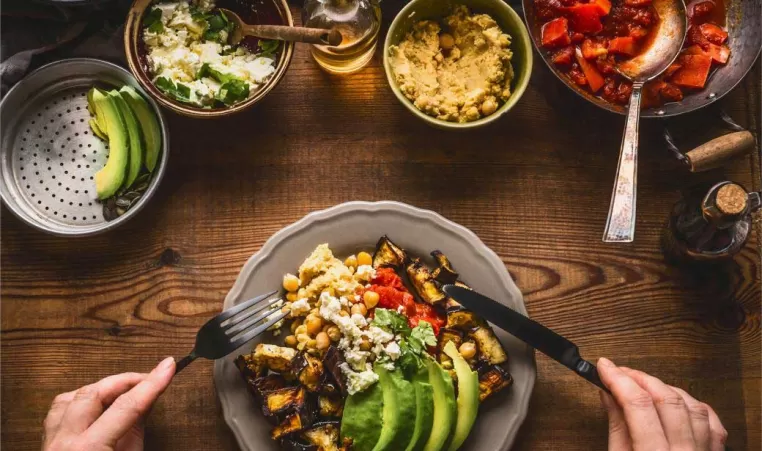Our Top 5 Tips for Eating Healthy Everyday

By: Amy Tackett, MS, RDN
Your health and wellness goals can be made easy! Start by taking small steps each day to improve your nutrition and become a healthier you through these top five tips to healthy eating:
1. Plan
- Begin by organizing to create these steps and enable an environment for success. Remember that nutrition is not black and white. Strive for progress and not perfection!
- If a workweek is ahead of you, take time throughout your weekend to choose your meals for the week ahead. This time is worth the investment when Monday comes around and you are able to focus on the day ahead, rather than the meals for you and your family.
- Choose staple foods for your breakfasts, lunches and dinner; such as lean meat with fresh produce as sides. Plan for easy grab and go snacks, such as a banana with almonds to help curb hunger! Create a grocery list and shop for these ingredients. Prepare meals ahead of time for ease. (Nutritionist tip: Some meals do not keep well by preparing ahead of time. Keep a calendar of dinners for your week. Cut, wash and marinate ahead of time. Then fully prepare foods the night of. Taking the guessing away is half of the battle!)
2. Choose Whole Foods
- Healthy eating does not have to be complicated! Make a goal for 80% of food choices to come from whole food sources. This could include fresh fruits and vegetables, nuts and seeds. Add lean meats for protein and whole grains for added fiber!
- Equally as important is to enjoy the foods you eat! This way you are able to maintain a healthy lifestyle. Try new fruits and vegetables and discover which you prefer. Add variety and color to keep it interesting!
*Nutritionist Tip: canned, frozen and some packaged foods are quick, easy and still a nutrient dense whole food. Check the packaging and nutrition labels to ensure these products do not contain any added ingredients such as a sauce or added sugar.
3. Balance Meals
- Balanced meals should include a protein, fat and carbohydrate source. Choose a protein source such as chicken, fish or eggs. Use oil in cooking or incorporate nuts and seeds as your fat source. Allow for fruits, vegetables and whole grains to be your primary carbohydrate source. An example of a breakfast could be a veggie filled omelet with a side of sweet potato hash. Let this balanced practice be included in your snacks as well! Snacks could include a low-fat yogurt with fruit or your favorite cut vegetables with low-fat ranch or hummus.
4. Eat in Moderation
- First and foremost, what are the correct portions to be eating? ChooseMyPlate.gov is a great tool and resource that provides recommendations based on age and gender. The USDA’s current nutrition guide “MyPlate” depicts accurate portions based on a plate and glass with the food group divisions. A key recommendation is creating a plate that is half fruits and vegetables! (See Healthy Eating Tip #2!)
- When eating in moderation, practice mindful eating. This is the conscious effort and awareness of your food choices. Notice your physical hunger and satiety cues for when to eat and when to stop. (Nutritionist tip: Instead of thinking or saying “I am full,” try replacing it with “I am no longer hungry.” Distractions while eating may enable eating to a point of discomfort. *Focus on your cues and know when you are no longer hungry!)
5. Drink Plenty of Water
- Do not let your body be confused between hunger and thirst! Drink plenty of water and- Hydrate. Hydrate. Hydrate. Water is an important function in the body and its metabolism. A general recommendation is for adults to drink 9 to 12 cups of drinking water each day. (Nutritionist Tip: Try sparkling water if you prefer a carbonated beverage or added fruits and vegetables for additional flavor!)
References:
United States Department of Agriculture (USDA). (2005). Dietary Reference Intakes for Water, Potassium, Chloride, and Sulfate. Retrieved from https://www.nap.edu/read/10925/chapter/6
Fletcher, M. (2018). What is Mindful Eating? Mindful. Retrieved from www.mindful.org/what-is-mindful-eating/
United States Department of Agriculture (USDA). (2018). What is MyPlate? USDA. Retrieved from https://www.choosemyplate.gov/
Amy Tackett is the Registered Nutritionist Dietitian for the YMCA of Greater Dayton. Interested in learning more? See our Nutrition page.
